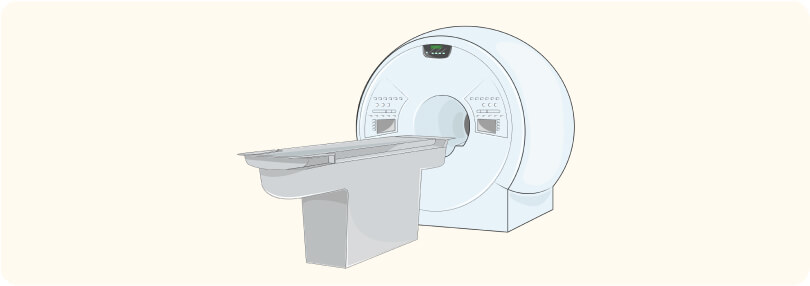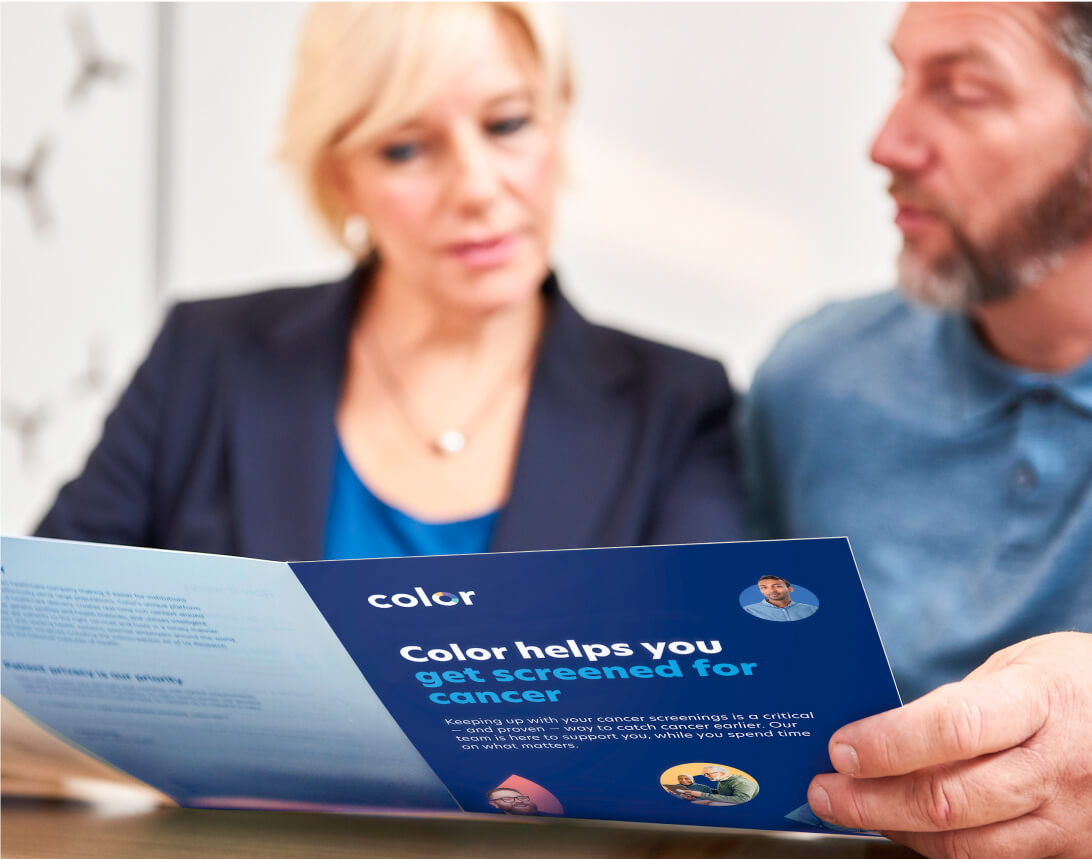Disclaimer:
The American Cancer Society is a nonprofit organization that routinely publishes guidelines but does not provide medical or clinical care.
Lung screening — even cooler than smoking used to be.
Color and the American Cancer Society want to make it simple to get screened.
Color Health’s Lung Screening Access Program, based on the American Cancer Society screening guidelines, takes care of everything from the physician ordering the scan, to finding a local radiology clinic, and even booking your appointment.
Are you eligible for a low-dose CT scan to screen for lung cancer?
The American Cancer Society recommends yearly lung cancer screening with a low-dose CT scan (LDCT) for those who meet all of the criteria below:
- Age 50-80
- Currently or previously smoked
- Have smoked 20+ pack years
Check your pack years:
A pack-year is equal to smoking 1 pack (or about 20 cigarettes) per day for a year.
The test is painless and takes less than 10 minutes.

A low-dose CT scan of your lungs is the recommended screening test. Imagine it like a souped-up X-ray machine that is able to create super detailed images of your insides.

It uses less radiation than a typical CT scan, which is why it is safe and recommended every year.

Getting this screening test regularly can catch lung cancer early – even before symptoms show up.
Common Questions
- Step 1: Provide the necessary information for a Color doctor to assess eligibility for an ldCT scan.
- Step 2: For eligible patients, a Color care advocate will help look for a convenient imaging center. If the patient has insurance, Color will look for in-network options. If they don’t have insurance, Color will look for free or low-cost options.
- Step 3: The patient goes to get their ldCT scan.
- Step 4: When results are ready, Color will review them and follow up with the patient. If anything is abnormal, over the next year we’ll help connect you with a local care provider for additional care.
Beyond this ldCT screening, it is recommended that patients work with their local care provider for healthcare needs, including yearly lung cancer screening as long as they are eligible.
At no cost, Color will help you navigate the process — we can provide consultations, write referrals, find a radiology clinic near you, help you book an appointment and even navigate your insurance coverage. You are responsible for the cost of the scan. For most people who meet eligibility criteria, screening is covered by Medicare and most private insurance plans with no cost sharing. Some insurance plans may not be following the updated guideline from the American Cancer Society yet. If your insurance does not cover the full costs of screening or if you don’t have insurance, we will try to help you find low or no cost options.
Yes! No shame or judgment here. Whether you want to stop smoking, aren’t sure you’re ready to quit, or don’t plan to stop, we are here for you. Just check the eligibility requirements, and if you meet the criteria, get scheduled with Color today. Catching cancer early often allows for a higher likelihood of successful treatment.
Yes! The most important change in the updated guideline from the American Cancer Society is that the number of years since quitting smoking is no longer a qualifier for starting or stopping yearly screening. That means a person who used to smoke with at least a 20 pack-year history, whether they quit yesterday or 30 years ago, is considered to have a high risk for developing lung cancer and should be screened with a yearly low-dose CT scan. Screening may or may not be right for you based on your other medical history — if you have questions, it’s important to talk with a doctor at Color about the benefits, limitations, and possible risks of screening.
Some insurance plans may not be following the updated guidelines yet. If your insurance does not cover the full costs of screening or if you don’t have insurance, we will try to help you find low or no cost options.
While smoking cigarettes is the leading cause of lung cancer, there are many other risk factors. The American Cancer Society details other risk factors here.
If you have any of the following symptoms, it is recommended you visit your primary care provider or an urgent care clinic for evaluation: Coughing that gets worse or doesn’t go away, coughing up blood, unexplained changes to your breathing in the past month, unexplained weight loss, or persistent and severe fatigue. A low dose CT scan may not be the right test for you.
If your CT scan finds something abnormal, like a lung nodule, your clinician may recommend repeating the CT scan at a later date to see if it changes over time. Depending on the size, shape and location, your clinician might recommend seeing a pulmonologist for further evaluation, which may include taking a small sample (biopsy) of the nodule to check for cancer cells.
- Step 1: Provide the necessary information for a Color doctor to assess eligibility for an ldCT scan.
- Step 2: For eligible patients, a Color care advocate will help look for a convenient imaging center. If the patient has insurance, Color will look for in-network options. If they don’t have insurance, Color will look for free or low-cost options.
- Step 3: The patient goes to get their ldCT scan.
- Step 4: When results are ready, Color will review them and follow up with the patient. If anything is abnormal, over the next year we’ll help connect you with a local care provider for additional care.
Beyond this ldCT screening, it is recommended that patients work with their local care provider for healthcare needs, including yearly lung cancer screening as long as they are eligible.
At no cost, Color will help you navigate the process — we can provide consultations, write referrals, find a radiology clinic near you, help you book an appointment and even navigate your insurance coverage. You are responsible for the cost of the scan. For most people who meet eligibility criteria, screening is covered by Medicare and most private insurance plans with no cost sharing. Some insurance plans may not be following the updated guideline from the American Cancer Society yet. If your insurance does not cover the full costs of screening or if you don’t have insurance, we will try to help you find low or no cost options.
Yes! No shame or judgment here. Whether you want to stop smoking, aren’t sure you’re ready to quit, or don’t plan to stop, we are here for you. Just check the eligibility requirements, and if you meet the criteria, get scheduled with Color today. Catching cancer early often allows for a higher likelihood of successful treatment.
Yes! The most important change in the updated guideline from the American Cancer Society is that the number of years since quitting smoking is no longer a qualifier for starting or stopping yearly screening. That means a person who used to smoke with at least a 20 pack-year history, whether they quit yesterday or 30 years ago, is considered to have a high risk for developing lung cancer and should be screened with a yearly low-dose CT scan. Screening may or may not be right for you based on your other medical history — if you have questions, it’s important to talk with a doctor at Color about the benefits, limitations, and possible risks of screening.
Some insurance plans may not be following the updated guidelines yet. If your insurance does not cover the full costs of screening or if you don’t have insurance, we will try to help you find low or no cost options.
While smoking cigarettes is the leading cause of lung cancer, there are many other risk factors. The American Cancer Society details other risk factors here.
If you have any of the following symptoms, it is recommended you visit your primary care provider or an urgent care clinic for evaluation: Coughing that gets worse or doesn’t go away, coughing up blood, unexplained changes to your breathing in the past month, unexplained weight loss, or persistent and severe fatigue. A low dose CT scan may not be the right test for you.
If your CT scan finds something abnormal, like a lung nodule, your clinician may recommend repeating the CT scan at a later date to see if it changes over time. Depending on the size, shape and location, your clinician might recommend seeing a pulmonologist for further evaluation, which may include taking a small sample (biopsy) of the nodule to check for cancer cells.


